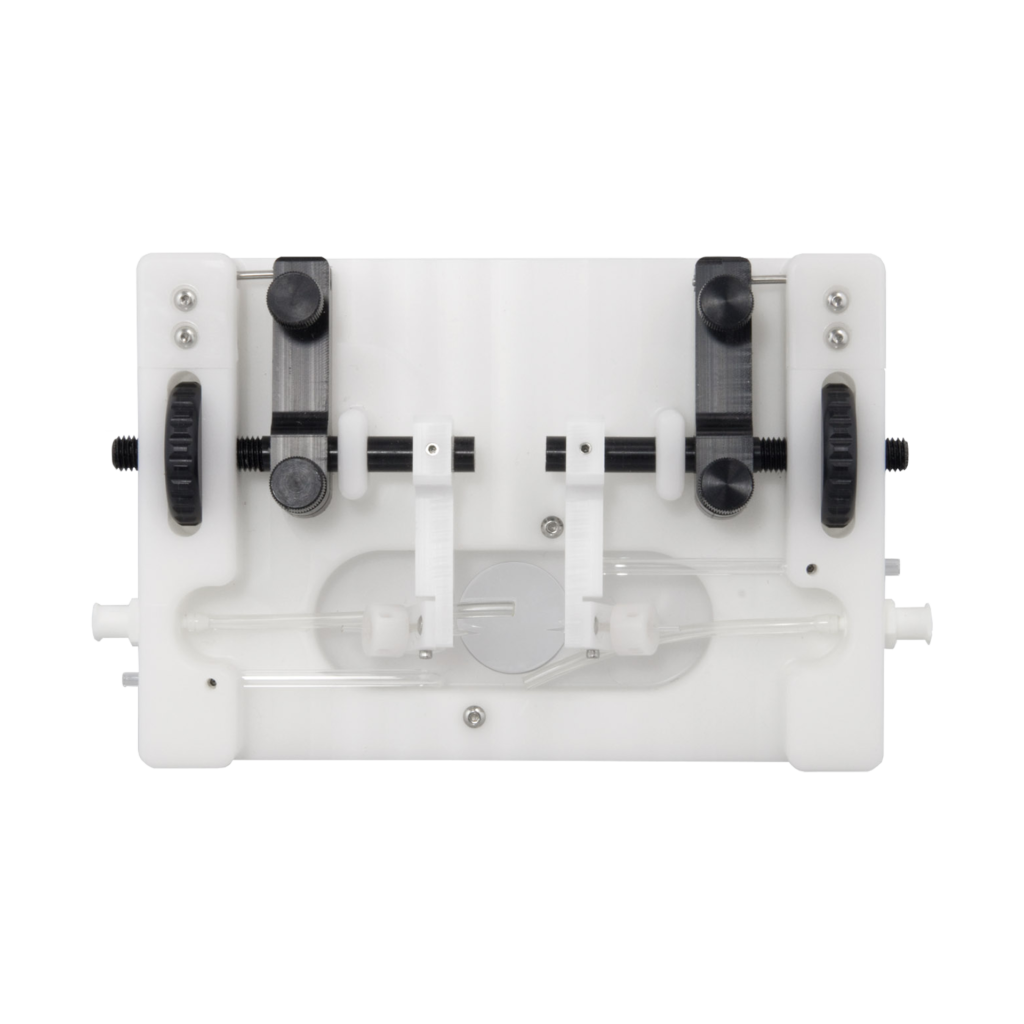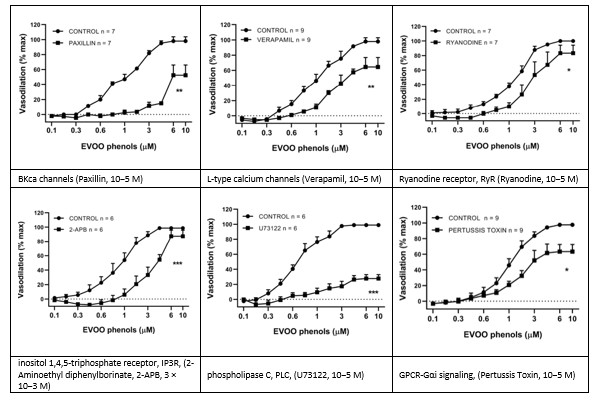System Used:
Pressure Arteriography

The increase in wealth and standards of living around the world has resulted in a growing aging demographic. Consequently, there has been an increase in aging-related deaths associated with cardiovascular diseases (CVDs), and the trends continue to rise. Medical research has responded with increasing research efforts to treat and prevent CVDs.
The most significant and prevalent cause of CVDs is systemic arterial hypertension. Although it’s been long established that a healthy lifestyle is the best method to manage hypertension combat CVD (healthy diet, regular exercise, abstaining from smoking, moderate alcohol consumption, etc.), the ability to control hypertension and lower CVD risk is not always possible. Therefore, nutra-pharmaceutical solutions are being investigated as a way to enhance our ability to address CVDs.
One such potential solution is the daily consumption of Extra Virgin Olive Oil (EVOO), prevalent in the “Mediterranean Diet” associated with various beneficial health effects, including reducing the incidence of CVDs. In the study presented here, the physiological mechanisms responsible for the observed beneficial effect of EVOO’s were investigated.  EVOO chemical composition can be differentiated into the saponifiable fraction (98–99% of EVOO), characterized by a high content of monounsaturated fatty acid (MUFA), and the unsaponifiable fraction (1–2% of EVOO) including phenols. Previously, EVOO anti-hypertensive effects were associated with MUFAs, predominantly oleic acid, but recent and more prevailing evidence implies a more driving role for the unsaponifiable fraction phenolic component.
Rossana D’Agostino, in collaboration i.e., Maria De Luca and Maurizio Mandalà, researching effects of olive oil in cardiac vascular disease, published that EVOO on lowering blood pressure and development.
Previously, they disclosed that EVOO phenols have vasodilatory effect on rat resistance mesenteric artery (MA) involving activation of the large-conductance calcium-activated potassium (BKca) channels in the vascular smooth muscle cells (VSMCs). Building on this their present study investigated the mechanism of action.
Investigating the mechanisms of action of EVOO phenols on mesenteric resistance arteries, 18–23 weeks Sprague-Dawley rats MA were harvested. Utilizing Living Systems pressure myograph, EVOO phenols effects were investigated in the presence of several inhibitors
EVOO chemical composition can be differentiated into the saponifiable fraction (98–99% of EVOO), characterized by a high content of monounsaturated fatty acid (MUFA), and the unsaponifiable fraction (1–2% of EVOO) including phenols. Previously, EVOO anti-hypertensive effects were associated with MUFAs, predominantly oleic acid, but recent and more prevailing evidence implies a more driving role for the unsaponifiable fraction phenolic component.
Rossana D’Agostino, in collaboration i.e., Maria De Luca and Maurizio Mandalà, researching effects of olive oil in cardiac vascular disease, published that EVOO on lowering blood pressure and development.
Previously, they disclosed that EVOO phenols have vasodilatory effect on rat resistance mesenteric artery (MA) involving activation of the large-conductance calcium-activated potassium (BKca) channels in the vascular smooth muscle cells (VSMCs). Building on this their present study investigated the mechanism of action.
Investigating the mechanisms of action of EVOO phenols on mesenteric resistance arteries, 18–23 weeks Sprague-Dawley rats MA were harvested. Utilizing Living Systems pressure myograph, EVOO phenols effects were investigated in the presence of several inhibitors
 Their results indicate that with the use of these inhibitors, EVOO phenols dose-dependent vasodilate MA requires activation of BKca channels, possibly essential machinery for artery vasodilation.
Future directions from this study towards human application would work from ex vivo work with the Living Systems pressure myography system towards in vivo work like Prof. Woolard’s done in Nottingham University. This could then be further improved with more age-, and condition/diet-matched rodents to the human situation, aging/life-style related disease, to assess ingestible levels of nutra-, pharmaceuticals levels of these EVOO phenols for treatment humans not living in accordance to the Mediterranean diet.
Reference:
D’Agostino R, Barberio L, Gatto M, Tropea T, De Luca M, Mandalà M. Extra Virgin Olive Oil Phenols Vasodilate Rat MesentericResistance Artery via Phospholipase C (PLC)-CalciumMicrodomains-Potassium Channels (BKCa) Signals. Biomolecules. 2021;11(2):137. Published 2021 Jan 21. doi:10.3390/biom11020137
For more information about the Pressure Arteriograph Systems, please contact Scintica Instrumentation (info@scintica.com).
Their results indicate that with the use of these inhibitors, EVOO phenols dose-dependent vasodilate MA requires activation of BKca channels, possibly essential machinery for artery vasodilation.
Future directions from this study towards human application would work from ex vivo work with the Living Systems pressure myography system towards in vivo work like Prof. Woolard’s done in Nottingham University. This could then be further improved with more age-, and condition/diet-matched rodents to the human situation, aging/life-style related disease, to assess ingestible levels of nutra-, pharmaceuticals levels of these EVOO phenols for treatment humans not living in accordance to the Mediterranean diet.
Reference:
D’Agostino R, Barberio L, Gatto M, Tropea T, De Luca M, Mandalà M. Extra Virgin Olive Oil Phenols Vasodilate Rat MesentericResistance Artery via Phospholipase C (PLC)-CalciumMicrodomains-Potassium Channels (BKCa) Signals. Biomolecules. 2021;11(2):137. Published 2021 Jan 21. doi:10.3390/biom11020137
For more information about the Pressure Arteriograph Systems, please contact Scintica Instrumentation (info@scintica.com).
 EVOO chemical composition can be differentiated into the saponifiable fraction (98–99% of EVOO), characterized by a high content of monounsaturated fatty acid (MUFA), and the unsaponifiable fraction (1–2% of EVOO) including phenols. Previously, EVOO anti-hypertensive effects were associated with MUFAs, predominantly oleic acid, but recent and more prevailing evidence implies a more driving role for the unsaponifiable fraction phenolic component.
Rossana D’Agostino, in collaboration i.e., Maria De Luca and Maurizio Mandalà, researching effects of olive oil in cardiac vascular disease, published that EVOO on lowering blood pressure and development.
Previously, they disclosed that EVOO phenols have vasodilatory effect on rat resistance mesenteric artery (MA) involving activation of the large-conductance calcium-activated potassium (BKca) channels in the vascular smooth muscle cells (VSMCs). Building on this their present study investigated the mechanism of action.
Investigating the mechanisms of action of EVOO phenols on mesenteric resistance arteries, 18–23 weeks Sprague-Dawley rats MA were harvested. Utilizing Living Systems pressure myograph, EVOO phenols effects were investigated in the presence of several inhibitors
EVOO chemical composition can be differentiated into the saponifiable fraction (98–99% of EVOO), characterized by a high content of monounsaturated fatty acid (MUFA), and the unsaponifiable fraction (1–2% of EVOO) including phenols. Previously, EVOO anti-hypertensive effects were associated with MUFAs, predominantly oleic acid, but recent and more prevailing evidence implies a more driving role for the unsaponifiable fraction phenolic component.
Rossana D’Agostino, in collaboration i.e., Maria De Luca and Maurizio Mandalà, researching effects of olive oil in cardiac vascular disease, published that EVOO on lowering blood pressure and development.
Previously, they disclosed that EVOO phenols have vasodilatory effect on rat resistance mesenteric artery (MA) involving activation of the large-conductance calcium-activated potassium (BKca) channels in the vascular smooth muscle cells (VSMCs). Building on this their present study investigated the mechanism of action.
Investigating the mechanisms of action of EVOO phenols on mesenteric resistance arteries, 18–23 weeks Sprague-Dawley rats MA were harvested. Utilizing Living Systems pressure myograph, EVOO phenols effects were investigated in the presence of several inhibitors
 Their results indicate that with the use of these inhibitors, EVOO phenols dose-dependent vasodilate MA requires activation of BKca channels, possibly essential machinery for artery vasodilation.
Future directions from this study towards human application would work from ex vivo work with the Living Systems pressure myography system towards in vivo work like Prof. Woolard’s done in Nottingham University. This could then be further improved with more age-, and condition/diet-matched rodents to the human situation, aging/life-style related disease, to assess ingestible levels of nutra-, pharmaceuticals levels of these EVOO phenols for treatment humans not living in accordance to the Mediterranean diet.
Reference:
D’Agostino R, Barberio L, Gatto M, Tropea T, De Luca M, Mandalà M. Extra Virgin Olive Oil Phenols Vasodilate Rat MesentericResistance Artery via Phospholipase C (PLC)-CalciumMicrodomains-Potassium Channels (BKCa) Signals. Biomolecules. 2021;11(2):137. Published 2021 Jan 21. doi:10.3390/biom11020137
For more information about the Pressure Arteriograph Systems, please contact Scintica Instrumentation (info@scintica.com).
Their results indicate that with the use of these inhibitors, EVOO phenols dose-dependent vasodilate MA requires activation of BKca channels, possibly essential machinery for artery vasodilation.
Future directions from this study towards human application would work from ex vivo work with the Living Systems pressure myography system towards in vivo work like Prof. Woolard’s done in Nottingham University. This could then be further improved with more age-, and condition/diet-matched rodents to the human situation, aging/life-style related disease, to assess ingestible levels of nutra-, pharmaceuticals levels of these EVOO phenols for treatment humans not living in accordance to the Mediterranean diet.
Reference:
D’Agostino R, Barberio L, Gatto M, Tropea T, De Luca M, Mandalà M. Extra Virgin Olive Oil Phenols Vasodilate Rat MesentericResistance Artery via Phospholipase C (PLC)-CalciumMicrodomains-Potassium Channels (BKCa) Signals. Biomolecules. 2021;11(2):137. Published 2021 Jan 21. doi:10.3390/biom11020137
For more information about the Pressure Arteriograph Systems, please contact Scintica Instrumentation (info@scintica.com).
